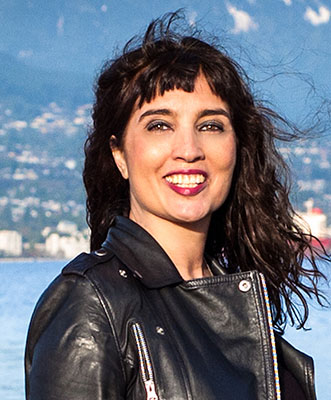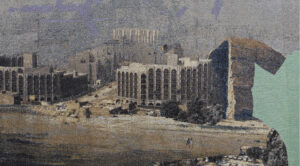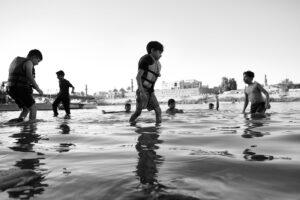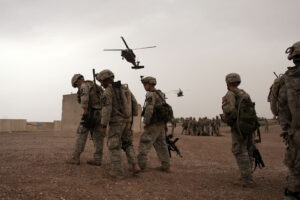Hadani Ditmars
As Iraqis wait in yet another political limbo for a clear winner to emerge from last fall’s elections, a renewed focus on art and culture in the land of the two rivers claims a small victory.
On the heels of April’s Al-Wasiti fine arts festival in Baghdad — initiated in 1972 with long hiatuses due to sanctions and more recently to mass anti-government protests — Qasim Sabti, Iraq’s elder statesman of the art world, holds forth in the garden of his lovely al-Hewar Gallery in Wazeriya.
“Since last December,” says Sabti, the long-time president of the Iraqi Artists society, “Baghdad has seen an explosion of new exhibitions.”
https://www.youtube.com/watch?v=AYMncx0rujE&ab_channel=AsmaaAlanbariAfter the well-known Akkad Gallery closed its iconic Abu Nawas location in 2011, owner Haider Hashem re-opened the gallery in a new location in Karradeh this past March, not far from The Gallery, Baghdad’s biggest new art space that opened last fall under the auspices of the Al Handal group. At the same time, two prominent private collectors with a wealth of 20th and 21st century Iraqi art opened Baghdada Gallery on Alnadhal street, between Bab al Shorji and Karradeh, in the offices of a Catholic church. Meanwhile Anaween Gallery was opened by a local filmmaker in 2021 in Adhimiya.
Now galleries are open in the evening for the first time in years due to increased security and Karradeh has replaced Abu Nawas as the new gallery neighborhood.
It’s certainly happy news that Baghdad is now experiencing more art shows than car bombs, especially coming from Sabti, a preeminent artist, gallerist, and survivor of Iraq’s fickle fortunes. The wily bohemian — who lives, works, and exhibits in a 1920s villa once owned by Iraq’s minister of defense under King Faisal — is a shrewd businessman as well as an artist. When I first met him in the wake of the 2003 invasion, he boasted that both Paul Bremer and Saddam Hussein had been visitors to his gallery. “They were both here,” he recounted. “They came and ate mazgouf with me in the garden.” In many ways, the al-Hewar Gallery is a crucible of Iraqi culture.
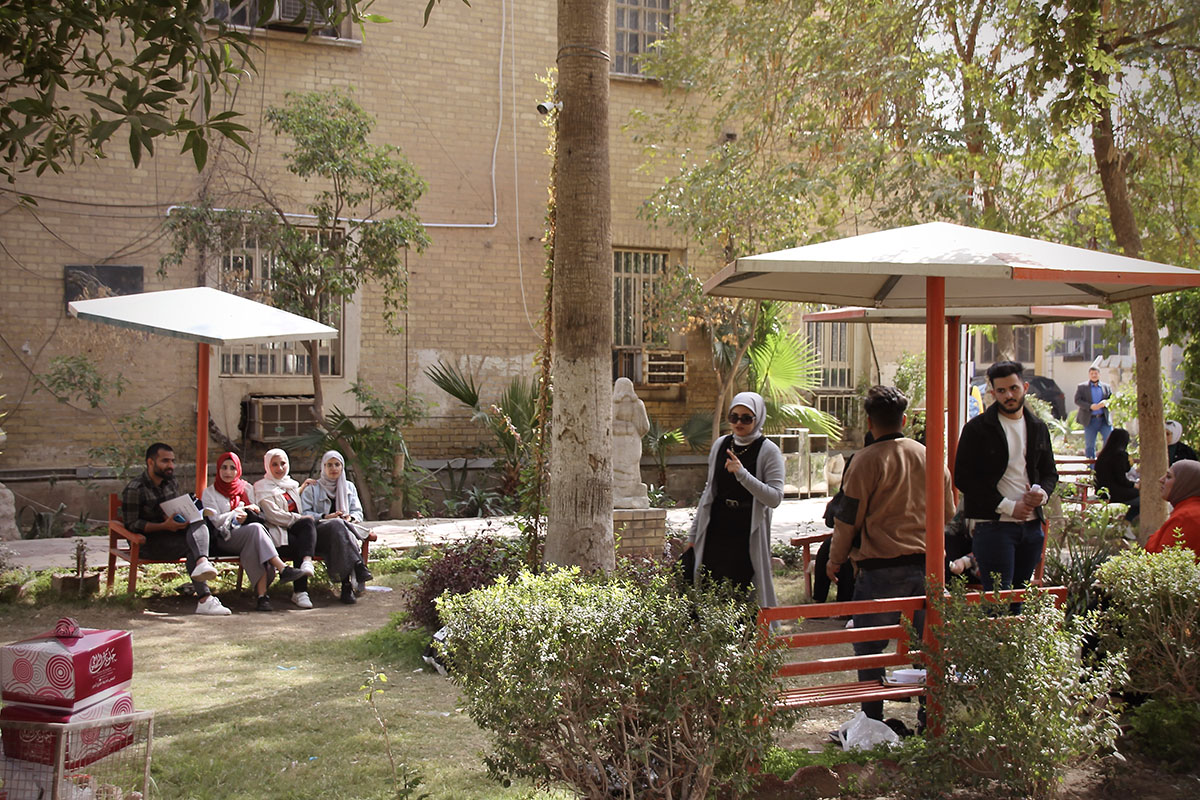
Then a popular post-invasion spot for European diplomats and U.N. workers, the gallery — located a few minutes from the College of Fine Arts — attracted dozens of young artists for afternoon tea in the ad hoc garden café. But as the reality of post-invasion life grew darker, there were fewer and fewer buyers; right across the street was the Turkish embassy, which would be bombed not long after my first visit.
The artwork then was still very much in a decorative vein. A would-be Iraqi Chagall exhibited her painting of a lively gypsy dance. Sabti’s own work featured fantastical creatures dredged up from Sumerian mythology. The only works that offered even a hint of darkness were an abstract oil painting with suggestions of flames and smoke, and a sculpture of spy-like figures having a clandestine meeting. When pressed, Sabti offered a cryptic interpretation. “We artists now are like a man holding a dove between two fires — one beside us and one in the distance. We cannot fight either fire, so we’d rather play with the dove.”
People came to his gallery, said Sabti, to escape the violent reality of daily life and to celebrate the survival of Iraqi culture rather than to be reminded of the struggle to survive. I even staged and performed in a concert there in October of 2003 with Iraqi cellist Karim Wasfi, a fundraiser for a project called “garden of peace” — aimed at assisting displaced women and children — that would ultimately be foiled by security concerns. But exploding cars and deadly statistics did not seem to interrupt Sabti’s genteel routine in the least. The al-Hewar stayed open through the worst of the troubles and even staged an exhibition in the summer of 2004 called the Abu Gulag Freedom Park.
The history of Iraqi art has been inexorably tied to its politics. Under King Faisal, in spite of the famed Iraqi pioneers like Faeq Hassan, there was a trend toward inoffensive traditional decorative artwork, pictures of horses and the like for wealthy clients. When Abdul Qarim Kassem came to power, strong, more overtly political works like Jawad Salim’s Tahrir Square — also a rallying point for recent protests — were born. A vogue for public art and murals gave way to a period of art that glorified Saddam. Apolitical abstract expressionism lasted for a very long time in Iraq after it had fallen out of favor in the West.
But the Iran/Iraq war, says Sabti, “shook the soul of many young artists.”

While many artists were drafted to the frontlines, the era does have some memorable moments in terms of public art, notably Ismail Fatah al Turk’s 1983 Martyrs’ Monument — an elegant turquoise dome, evocative of the Abbasid era, split in two and mounted at the center of an artificial lake. The iconic sculpture was preceded by 1982’s Monument to an Unknown Soldier, by Italian architect Marcello D’Olivo, based on a conceptual design by Iraqi sculptor Khaled al Rahal and 1989’s Victory Arch, a pair of giant arms with crossed swords featuring the helmets of captured Iranian soldiers at the base. The official name of the triumphal arches, the Swords of Qādisiyyah, is an allusion to the seventh century battle when Arab armies defeated Sassanid Iran and captured their capital Ctesiphone, where an arch marks the entrance to the ancient Imperial Palace. It was designed in close collaboration with Saddam Hussein first by Al-Rahal and then, after his death by Mohammed Ghani Hikmat.
Ironically, it was the end of the war and the beginning of the embargo era that marked a cultural renaissance of sorts, as artists returned from war to sanctions and economic collapse.
When the al-Hewar gallery opened in 1992, it was only the second private gallery after the Orfali center in what had been a heavily state-subsidized scene. “A movement of Iraqi artists grew from this place,” says Sabti. “Artists made more than state employees and had lots of time to paint.” The waiting list for a show was over a year and exhibitions enjoyed long runs.
During the embargo, notes Sabti, “there was suddenly a big market for Iraqi art” — albeit mainly from UN employees who administered the infamous oil-for-food program, and whose bloated salaries were taken from Iraqi oil revenues, while average Iraqis were allotted a miserable daily subsistence. Still, dozens of new galleries opened in the late ‘90s and early 2000s as foreigners snatched up Iraqi art.

After the 2003 invasion, security issues forced most of the new galleries to close down, the al-Hewar excepted. The al Wasiti festival, named for the famed 13th century Baghdadi artist, vanished during the embargo and enjoyed a single iteration in 2010. It resurfaced in 2017 and 2018, but was postponed in 2019 and 2021 due to the anti-government protest movement which in turn produced its own art. The Turkish Restaurant building — itself a bombed out survivor of 2003 — has now become a secular shrine, full of hopeful murals and angry graffiti, perched behind Tahrir Square.
The current art “explosion” Sabti mentions is the happy result of a hybrid marriage of state support and private sponsorship; a revival of the traditional government funding enjoyed under Saddam’s regime and a new post-invasion neoliberalism — Iraqi style — with a liberal helping of state capitalism. Private bankers with links to the National Bank of Iraq helped renovate the historic al Mutannabi street and nearby al-Rasheed street/Midan Square. While these areas once shut down at midday, now bookshops and cafés stay open until the wee hours, and artists and musicians throng the streets. The al-Rashid theatre has been restored and new murals of prominent writers and artists commissioned by Baghdad’s mayor Alaa Maan last January can now be found throughout the city.
The re-opening of the Iraqi Museum in March after a three-year hiatus due to protests and pandemic issues, also bodes well, as does the return of cultural tourism, thanks to a new visa on demand.
Zaha Hadid’s gorgeous and long-awaited National Bank building is restoring some architectural panache to the Jadriyah end of Abu Nawas. But its positioning between the newly revamped Hotel Babylon and the headquarters of a rather notorious Iranian backed Shia militia speak to ongoing troubles in a place where many gallerists are forced to pay local militias to stay in business. Meanwhile the Station, a co-working space owned by the Al Handal group with ties to both the national and private banks, who recently opened The Gallery, is also sponsored by UNESCO.
The relative success of the recent Al-Wasiti festival — which brought several prominent diaspora artists to Baghdad as well as the important Lebanese gallerist Saleh Barakat — yet was hastily and haphazardly put together in two weeks, is also a promising sign. It followed the appointment of artist Fakher Mohammed as head of the arts section at the Ministry of Culture, a post previously occupied by a technocrat, not an artist. Mohammed worked with funding from the Association of Private Banks to renovate the Museum of Modern Art on Haifa Street in time for the festival.
An exhibition on display during the festival featured almost 100 pieces of art that were looted from the museum (or Saddam Arts Center as it was then known) and since recovered.
Tracked down after they were trafficked in Switzerland, the U.S., Qatar and neighboring Jordan, the sculptures and paintings, dating between the 1940s and 1960s, were displayed in a cavernous space that was once a restaurant.
They included important works by Fayiq Hassan and Jawad Salim. One piece by Salim, depicting a woman with a slender neck and raised arms and known as the “maternal statue” is reputed to be worth hundreds of millions of dollars. It was discovered randomly at a Baghdad antique shop by sculptor Taha Wahib, who bought it for just $200 and returned it to the Ministry.
Another exhibition showcasing contemporary artists included many prominent artists from the diaspora, among them Ahmed Al-Bahrani, an Iraqi sculptor based in Doha showing in Baghdad for the first time in a decade; Walid Rashid al Qaisi, a conceptual artist working with mixed media normally based in Jordan; and Sweden-based abstract painter Karim Sadoun.

Also included were Mohammed Al-Kinani, head of the visual arts department at the College of Fine Arts, who works in acrylic and mixed media; Baghdad based expressionist painter Wadhah Madhi; and Iraqi-Canadian artist Riyadh Ghenea (formerly known as Riyadh Hashim), who took his late mother’s surname recently as he worked on a show dedicated to her, evoking the divine feminine and Sumerian tradition. A highlight was the work of abstract painter Ahmed Al Said, an abstract painter who left for Sweden in 2011 and returned last year who has been chronicling changes in public spaces in Baghdad since 2003.
Young up and coming artists also had their work featured during the Al Wasiti festival, including Aladin Mohammed — known for his surrealist explorations of Iraqi folklore. His work has also been shown at the Akkad and The Gallery, along with work by abstract painter Haider Fakher and surrealist Noor Abd. The three will also be part of a group show — still the prevailing model in a country with a longer history of state-sponsored art than private galleries and solo exhibitions — sponsored by the Iraqi Artists Society in June 2022.
Mentorship of young artists by established ones continues to be an important part of the Iraqi art scene. At the Bronze Gallery, right across the street from the College of Fine Arts in Wazeriya, there is a current exhibition of pottery by septuagenarian Akram Nadji that has been popular with students.
Educational opportunities with diaspora artists continue. London based Hana Mallalah just had an open studio at the Ministry of Culture — the first time in many years that a diaspora artist has done this in Baghdad — and Nadim Kufi, an Amsterdam-based artist, will be doing an open studio later in May.
“I’ve been back in Iraq since 2011,” says Sabti’s friend and colleague Riyadh Ghenea.
“Then you had to wait for months to see a show. Now I can’t keep up.”
But who is buying all this new art, I ask?
“The nouveau riche,” replies Sabti without missing a beat, “are the new collectors.”
“They want to invest in art as an alternative to keeping US dollars in their pocket. Now because the economy is up and down, they think art is a better investment.”
But the domestic market is tricky for Iraqi artists, says Ghenea, as the prices are so low. “I sell most of my work in Vancouver, Jordan and the Gulf,” he notes. He recently participated in a group show in Amman and will soon begin a residency in Jeddah.
Ghenea has just begun work as a curator at The Gallery, Baghdad’s biggest and newest art space in Karradeh that will soon expand to double its size, after a successful solo show there last fall. He refused to sell any of his work there as the offers were too low. While he could make a better living in the West, he says, he stays on in Baghdad because of his love for teaching at the Fine Arts College.
“I have a duty to bring my international experience to Baghdad,” he says, noting that many art school teachers are still operating from a curriculum frozen in the 1980s and inspired primarily by the Iraqi canon of “pioneers” like Faeq Hassan.

“I ask my students to think critically,” says Ghenea, “not just follow rules and imitate other artists. I tell them ‘try to be yourself.’”
His students, says Ghenea, are often more aware of what is going on in the art world now than their professors, making use of social media and YouTube to learn new techniques.
“The new generation thinks outside the box,” he explains. “They photograph and post their work on Instagram and Facebook so they don’t need galleries.”
In fact, Iraqi art has found a new life in the digital realm. Not just in terms of initiatives like The Virtual Museum of Iraq but also in the way that social media has contributed to narrowing the ever-present gap between Iraqi artists at home and in the diaspora.
“Now Iraqi artists in London can easily exchange ideas with colleagues in Baghdad,” says Ghenea.
While established UK-based artists like Hannah Mallalah are physically bridging the distance between “exile” and “home,” with frequent visits to Iraq, young up and coming artists in the diaspora are making liberal use of new technologies to create evocative art.
“Gilgamesh Contemporary,” a new multimedia show in London, is one example.This eco-feminist take on the epic of Gilgamesh, by London based Iraqi artist Asmaa Alanbari, reimagines the ancient story as a fable about climate change, which is now a greater threat to Iraqi heritage sites than ISIS as desertification and subsequent dams and flooding threaten dozens of ancient sites, and dust storms paralyze the nation.
A collage of images integrates cuneiform script from the original tale with images of ocean pollution, contemporary London, and social media footage of ISIS destroying Assyrian statues, at once linking tangible and intangible heritage, cultural loss, and displacement. Original music by Iraqi composer Layth Sadiq and live accompaniment by Iraqi oud player Ehsan Emam and performance by dancer Yen-Ching Lin (formerly with the Akram Khan Company) complete the mise-en-scène.
Still the virtual is a pale apparition of the actual and the atmosphere of Baghdad forms a vital part of Iraqi artistry.
“I am inspired by this city,” says Ghenea. “By its smells, colors, textures, its history and its crowds.”
“And this is still the soul of Baghdad, this place,” says Sabti. As young art students and nightingales alike flock to its spacious galleries and lush gardens, it’s hard to disagree. Like Iraqi artists, the gallery has weathered three decades of war and occupation, remaining an enduring symbol of beauty and hope.




